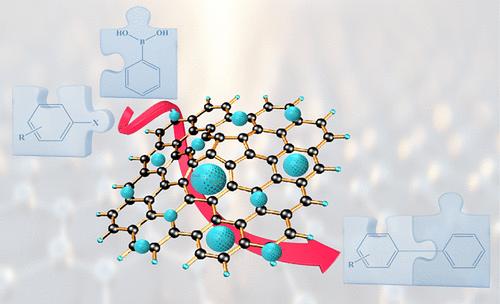以 Ag-Cu2O 为支撑的生物质衍生 rGO 催化铃木-宫浦交叉偶联
IF 3.9
2区 化学
Q2 CHEMISTRY, MULTIDISCIPLINARY
引用次数: 0
摘要
由于昂贵、有毒的均相催化剂所带来的挑战,为铃木-宫浦反应寻找经济、高效、环保的异相催化剂至关重要。本研究的核心目标是通过将罗勒种子(Ocimum basilicum L.)中提取的还原氧化石墨烯(rGO)与 Ag-Cu2O 复合结构相结合,制造出一种开创性的绿色催化剂。通过傅立叶变换红外光谱(FTIR)、扫描电子显微镜(SEM)、hHR-TEM、电致发光(EDS)、XPS、X射线衍射(XRD)、热重分析(TGA)和氮气吸附/解吸分析,对Ag-Cu2O/rGO纳米复合材料进行了全面表征。结果表明,纳米级 Ag-Cu2O 颗粒部分融入了从罗勒种子中提取的 rGO 片材中,成为 SMR 中芳基卤化物氧化加成的活性物种。在利用各种芳基卤化物和芳基硼酸合成双芳基化合物的铃木-米亚乌拉交叉偶联反应中,对这种强效纳米催化剂的催化功效进行了评估。研究结果表明,Ag-Cu2O/rGO 纳米催化剂具有快速的反应动力学(15 分钟)和值得称赞的产率(99%)。Ag-Cu2O/rGO 具有令人印象深刻的可回收性,可在四个循环中保持催化效率。将其作为绿色基底用于金属负载凸显了其潜力,提供了明确的配位位点。这种方法有利于制造稳定的异质催化剂,这对形成重要的化学键至关重要。其显著特点包括广泛的适用性、优异的功能耐受性、可扩展性和实用性。此外,这种方法有望实现安全流程的自动化,并能以中等到较高的效率对复杂分子进行高效的后期功能化,为化学合成中的各种应用带来广阔前景。本文章由计算机程序翻译,如有差异,请以英文原文为准。

Ag–Cu2O Supported Biomass-Derived rGO for Catalyzing Suzuki–Miyaura Cross-Coupling
The search for cost-effective, efficient, and ecofriendly heterogeneous catalysts for the Suzuki–Miyaura reaction is crucial due to challenges with expensive, toxic homogeneous catalysts. This study centrally aims at crafting a pioneering green catalyst by adorning reduced graphene oxide (rGO), sourced from basil seeds (Ocimum basilicum L.), with an Ag–Cu2O composite structure. Comprehensive characterization of the Ag–Cu2O/rGO nanocomposite was conducted through FTIR, SEM, hHR-TEM, EDS, XPS, XRD, TGA, and N2 adsorption/desorption analyses. Results showed that nanosized Ag–Cu2O particles were partially integrated into rGO sheets derived from basil seeds, acting as active species for oxidative addition with aryl halides in the SMR. The catalytic efficacy of this robust nanocatalyst was assessed in Suzuki–Miyaura cross-coupling reactions, targeting the synthesis of biaryls employing various aryl halides and aryl boronic acids. The findings underscore that the Ag–Cu2O/rGO nanocatalyst manifests rapid reaction kinetics (15 min) alongside commendable yields (99%). The Ag–Cu2O/rGO demonstrates impressive recyclability, maintaining catalytic efficiency over four cycles. Utilizing it as a green substrate for metal loading highlights its potential, offering well-defined coordination sites. This approach facilitates stable heterogeneous catalyst fabrication, crucial for significant bond formations. Notable features include broad applicability, exceptional functional tolerance, scalability, and practicality. Moreover, it holds promise for automating safe processes and enabling efficient late-stage functionalization of complex molecules with moderate to high efficiency, presenting promising prospects for various applications in chemical synthesis.
求助全文
通过发布文献求助,成功后即可免费获取论文全文。
去求助
来源期刊

Langmuir
化学-材料科学:综合
CiteScore
6.50
自引率
10.30%
发文量
1464
审稿时长
2.1 months
期刊介绍:
Langmuir is an interdisciplinary journal publishing articles in the following subject categories:
Colloids: surfactants and self-assembly, dispersions, emulsions, foams
Interfaces: adsorption, reactions, films, forces
Biological Interfaces: biocolloids, biomolecular and biomimetic materials
Materials: nano- and mesostructured materials, polymers, gels, liquid crystals
Electrochemistry: interfacial charge transfer, charge transport, electrocatalysis, electrokinetic phenomena, bioelectrochemistry
Devices and Applications: sensors, fluidics, patterning, catalysis, photonic crystals
However, when high-impact, original work is submitted that does not fit within the above categories, decisions to accept or decline such papers will be based on one criteria: What Would Irving Do?
Langmuir ranks #2 in citations out of 136 journals in the category of Physical Chemistry with 113,157 total citations. The journal received an Impact Factor of 4.384*.
This journal is also indexed in the categories of Materials Science (ranked #1) and Multidisciplinary Chemistry (ranked #5).
 求助内容:
求助内容: 应助结果提醒方式:
应助结果提醒方式:


